Stargate SG-1 Season 6
Executive producers: Brad Wright, Robert C. Cooper, Michael Greenburg, Richard Dean Anderson
Original air dates: June 7, 2002 – March 23, 2003
Mission briefing. Even as SG-1 mourns the loss of Jackson, there’s a fresh attack from Anubis, as he uses a weapon to overload Earth’s Stargate so it will explode, taking the planet with it. SG-1 manages to save the Earth with a combination of Carter’s brains, O’Neill’s piloting skills, and a clever suggestion by Quinn, who replaces Jackson on SG-1. However, the Stargate itself is lost, forcing the U.S. to purchase use of the other Stargate from the Russians.
Thor also manages to break free of Anubis’s clutches, using his downloaded consciousness to take over Anubis’s mothership, which then crashes on Earth. SG-1 is able to contact the Asgard, who get Thor a new cloned body.
The Asgard have bigger problems, though: the Replicators have taken over their homeworld of Hala and now have taken human form. SG-1 is able to stop them temporarily, but they’ll be back. In exchange, the Asgard help convince the superpowers of Earth to let the U.S. Air Force continue to administer the Stargate, when the U.S. and Russia reveal the Stargate program’s existence to Great Britain, France, and China.
Anubis isn’t the only Goa’uld causing problems. When O’Neill is blended with a Tok’ra to save his life, the symbiote Kanan finds itself compelled by O’Neill’s tendencies to go back for a woman he loved—a slave in Baal’s service. This leads to O’Neill being tortured by Baal. In addition, Nirrti’s continued experiments result in deadly changes to Quinn, which actually enable Quinn to help SG-1 defeat one of Baal’s underlings, Mot.
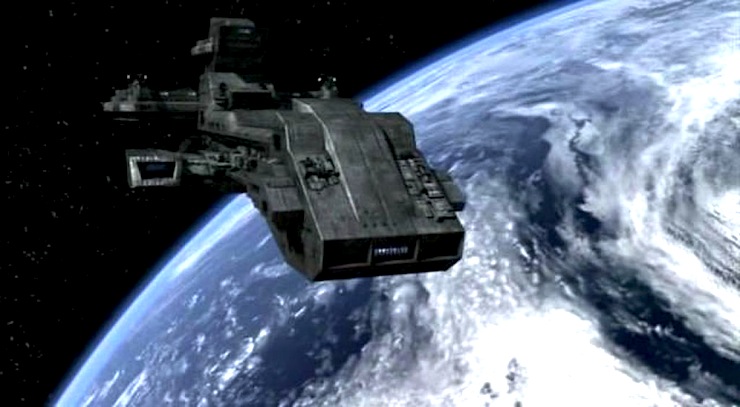
At home, the NID continues to be a problem. The rogue faction controlled by Simmons tries to steal Earth’s first starship, the Prometheus. They also clone the Goa’uld that Adrian Conrad was implanted with and use it to experiment on members of a small town, who are possessed by a collective Goa’uld consciousness when asleep. After that, Agent Barrett of the NID is assigned by the president to root out the rogue elements of the NID, with the help of—of all people—Senator Kinsey. This results in the NID framing O’Neill for an attempted assassination of Kinsey, but SG-1 manages to expose the conspiracy (which is done via alien technology from Area 51).
The three-way alliance among the Tau’ri, the Tok’ra, and the Jaffa rebellion almost is destroyed by a Goa’uld assassin, who fuels the ancient rivalry between the Jaffa (servants of the Goa’uld) and the Tok’ra (who fight the Goa’uld), even though they’re both on the same side now. Shortly afterward, the Tok’ra discover that the Pangarans have been using the dying body of Agyria, the queen from whom all Tok’ra descend, to create Tretonin, a healing drug. When a meeting of the Jaffa rebellion is ambushed, the Jaffa massacred, Teal’c manages to save himself and Bra’tac by sharing his symbiote larva with his mentor—but the symbiote dies, and the pair must now take Tretonin regularly to survive thenceforth. They begin their campaign to convince all Jaffa to use Tretonin to relieve them of their dependence on the Goa’uld to survive.
An Antarctic expedition reveals the frozen body of one of the Ancients who built the Stargate network—but the disease that killed them is also loosed, and almost kills O’Neill. Quinn’s people, the Kelownans, make an attempt at an alliance. The Earth is invaded by out-of-phase bugs. SG-1 encounters the Hebridans and Serrakins, and neither race is exactly what they expect. When the Prometheus has to crash on Tagrea, they set off some security issues with the planet, especially when they dig up a Stargate. And Maybourne tricks SG-1 into taking him offworld to a place he thinks is paradise, but turns out to be not so much.
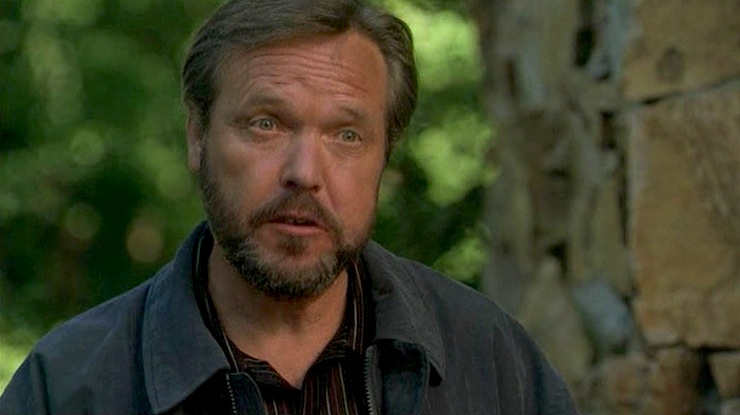
Anubis exposes Khonshu as a Tok’ra, and Khonshu’s First Prime Her’ak pledges his allegiance to Anubis. Then Anubis targets all the other System Lords, and SG-1 can only stop him with the help of the ascended Jackson—who’s already helped O’Neill and Teal’c from his ascended position before—and it involves a trip back to where it all began: on Abydos.
Best episode: “Abyss.” One of three occasions when Michael Shanks returns to play Jackson, but that’s not why this episode gets the top spot. It’s a tour-de-force for Richard Dean Anderson, a magnificent showcase for Cliff Simon, who takes the quickie walk-on role of Baal from “Summit”/“Last Stand” and makes him a bad guy to be reckoned with, a serious revival of the O’Neill-Jackson dynamic, with everything that these two characters are being showcased, plus there’s a good examination of what Tok’ra blending really means. The whole thing happens, not because of something Kanan did to O’Neill, but because of the influence of O’Neill on Kanan…
Highly honorable mention to “Allegiance,” which only didn’t get the top spot due to some bits of the plot that just don’t make any sense, but it works because it plays with the dynamics of the humans, Tok’ra, and Jaffa in interesting ways, and makes good use of the “locked planet” structure.
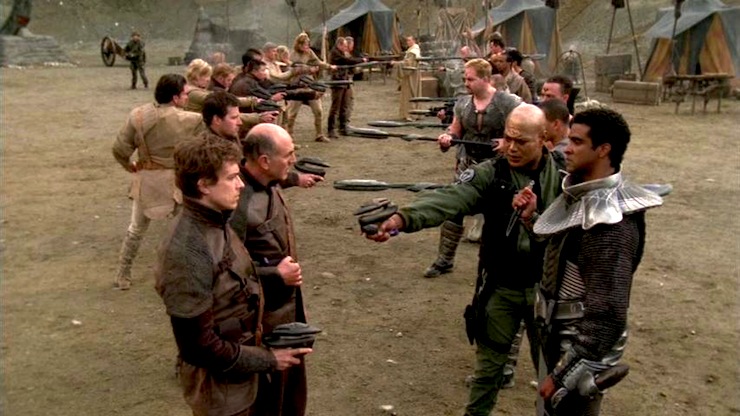
Also strong: the nifty take-over-the-ship adventure of “Prometheus,” the hilarious in-joke-laden goofiness of “The Other Guys,” and the alternate take on the characters in “The Changeling.”
Worst episode: “Paradise Lost,” in which the character of Samantha Carter is reduced to a blubbering wreck who is chewed out by Dr. frikkin Lee of all people, and instead of acting like a major in the Air Force, she instead turns into a puddle of goo crying on Teal’c’s shoulder. It’s embarrassing and stupid and pathetic, and ruins what should be a fun romp with Anderson and Tom McBeath as Maybourne being stuck on a planet together. But the show has done so well by Carter up to this point that this episode just leaves a horrendous taste in the mouth.
Runners up include “Nightwalkers” (which isn’t nearly as much of a horror movie as it wants to be), “Sight Unseen” (because the producers apparently forgot how awful “Bane” was), “Forsaken” (the only thing more boring would be to watch the paint used for this paint-by-numbers plot dry), and “Memento” (if they want to riff on Star Trek, fine, by why do a boring Trek riff?).
Can’t we just reverse the polarity? The SGC’s constant mucking about with alien technology has resulted in the Prometheus, and actual honest-to-gosh spaceship, which we first see in, appropriately, “Prometheus.” It has some issues—the ship is stolen before it’s finished, and they have to eject the engine on a test flight in “Memento” because it doesn’t work right—but it’s Earth’s first foray into becoming an actual power in the galaxy as opposed to an irritant.
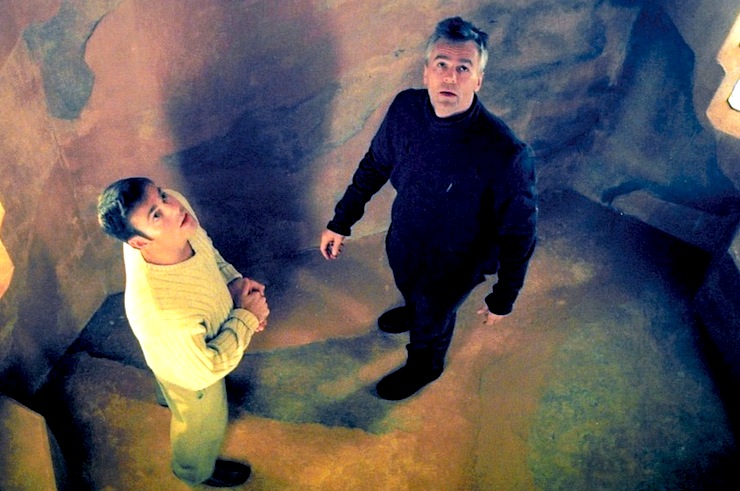
For cryin’ out loud! When he contracts a fatal illness in “Frozen,” O’Neill very very reluctantly agrees to be blended with a Tok’ra. But even as Kanan heals O’Neill, he also becomes influenced by O’Neill’s strong desire to never leave someone behind, and so he goes back to rescue a slave in Baal’s service, which leads to O’Neill being tortured by Baal by being killed and revived via sarcophagus over and over again in “Abyss.” O’Neill, who was never all that thrilled with the Tok’ra in the first place, becomes even more resentful of them, which leads to a really interesting conversation between him and Jacob in “Allegiance.”
It might work, sir. Carter—with an inspirational push from Quinn—saves the Earth again in “Redemption,” and also shows off her amazing improvisational science skills in “Prometheus” and “Forsaken.” Since many of her potential love interests were killed off last season, she gets a new one in the humanform Replicator Fifth in “Unnatural Selection,” whom she betrays on O’Neill’s order (and boy will they all come to regret that…).
Indeed. Teal’c loses his symbiote in “The Changeling,” as does Bra’tac. This changes his life rather significantly, as he must now rely on Tretonin to survive, and he no longer has “junior’s” healing ability to rely on.
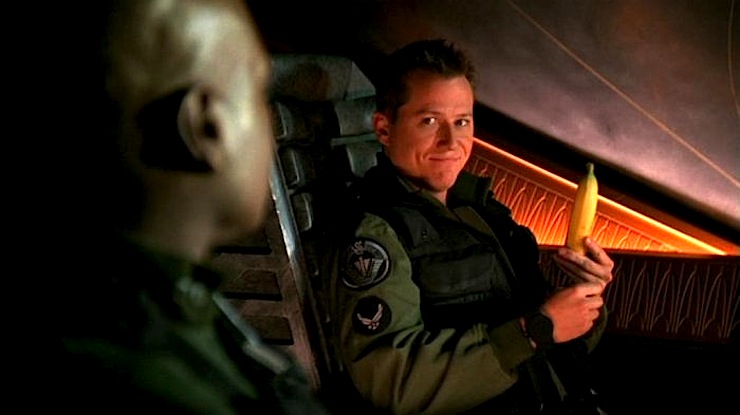
How do I know what color to wear? O’Neill is excessively reluctant to have Quinn replace Jackson, at least in part because Jackson died saving Quinn and his people. He only gives in because the Russians want the fourth SG-1 member to be one of theirs, and O’Neill would never go for that. Quinn’s photographic memory and compassion both prove useful throughout the season, as well as his ability to think quickly.
You have a go. Hammond does a good job representing the U.S. (aided by Davis) when the Stargate program is revealed to the other members of the UN security council, though in order to counteract Kinsey’s general dickishness, he has to call in Thor to intimidate the hell out of everyone.
I speak 23 different languages—pick one. Though he’s ascended, Jackson does show up three times to do the thing ascended folk aren’t actually supposed to do: interfere. He helps O’Neill get through being tortured in “Abyss” and helps Teal’c with his delusions while dying in “The Changeling,” in both cases helping them last long enough to be rescued by the rest of SG-1. Then, when Anubis threatens Abydos, Jackson takes a more active role.
Wayward home for out-of-work genre actors. Quantum Leap’s Dean Stockwell appears in “Shadow Play” as Quinn’s former mentor. John Billingsley took a break from playing Dr. Phlox on Star Trek: Enterprise to play Coombs in “The Other Guys,” while Peter Stebbings and Ingrid Kavelaars took a break from their recurring roles on Jeremiah to appear as, respectively, Malek in “Allegiance” and “Cure” and Major Gant in “Memento.” Gwynyth Walsh—who played the Klingon Lursa on a bunch of Star Trek episodes and in the movie Generations—also appears in “Cure,” while two other Trek regulars, John deLancie (“Prometheus”) and Ronny Cox (“Smoke and Mirrors,” “Disclosure”), make return engagements. Former star of The Questor Tapes (and regular guest on the Star Trek spinoffs and Babylon 5) Robert Foxworth also appears in “Memento.” George Wyner (of, among other things, Spaceballs fame) shows up in “Prometheus.” And Don Davis’s fellow Twin Peaks star Ian Buchanan appears in “Unnatural Selection.”
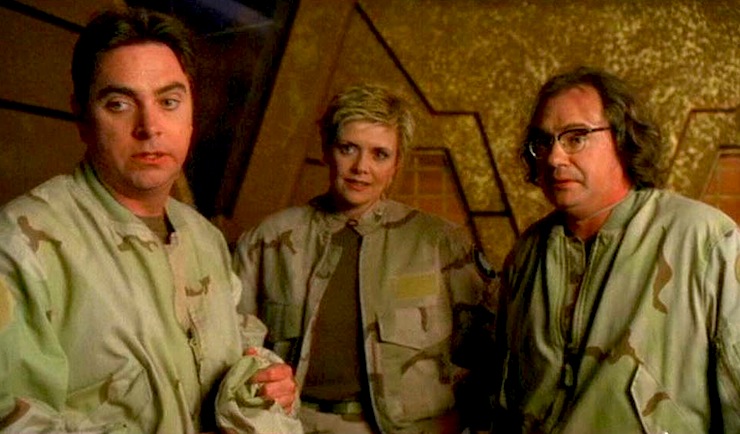
Trivial matters. This is the first season of the show to air first on what was then called the Sci-Fi Channel (now called SyFy). It was only intended to run for one season on Sci-Fi, as the channel’s primary interest was getting access to the show’s reruns, but it turned into such a huge hit for the network that they renewed it. Several episodes were written as if it were the last season, including final appearances for Nirrti, Simmons, and Adrian Conrad, as well as what was written as a final appearance for Maybourne, and the appropriately titled “Full Circle” brought the team back to Abydos. This would happen again in seasons seven and eight.
While SG-1 was never a huge hit for Showtime, it immediately became the highest rated dramatic series on Sci-Fi, leading to it lasting four years longer than expected on the channel and also resulting in two spinoffs.
It was never clear how, if the Goa’uld have genetic memory, the Tok’ra didn’t just know everything the Goa’uld did. “Cure” explains this by establishing that the Tok’ra descend from a different queen than the other Goa’uld.
We meet our first Ancient in “Frozen,” wherein we also learn that they were devastated by a plague, and “Full Circle” makes it clear that most of the Ancients ascended, and that Oma Desala is one of them. “Full Circle” also establishes that Anubis ascended, but then was cast out—but he’s still partly ascended, which is why he’s so powerful.
In addition to regulars Teryl Rothery, Carmen Argenziano, Tony Amendola, and Gary Jones, this season has return engagements from past guests deLancie, Cox, David Hewlett as McKay, Obi Ndefo as Rak’nor, Tom McBeath as Maybourne, Colin Cunningham as Davis, Peter Flemming as Barrett, Bill Dow as Lee, Musetta Vander as Shaun’ac, Neil Denis as Ry’ac, David Palffy as Anubis, Jacqueline Samuda as Nirrti (who also co-wrote the episode she appeared in), Bill Marchant as Conrad, Vince Crestejo as Yu, and, making his final appearance as Skaara, Alexis Cruz.
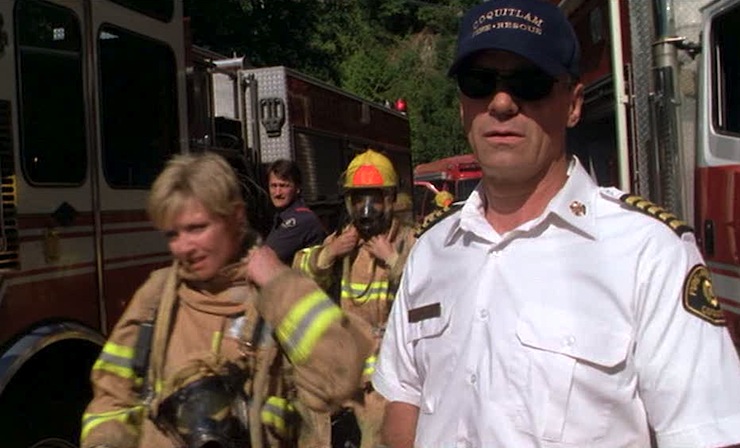
“The Changeling” was written by Christopher Judge, the actor’s second of four writing credits on the show.
The Prometheus is the first of many ships that Earth will have in its service. They’ll be seen regularly on all three shows moving forward, including one—the George Hammond—which will be commanded by Carter.
O’Neill is framed for shooting Kinsey via the technology used by the invading aliens in “Foothold.” The ashrak (established in “Line of Fire” as Goa’uld assassins) in “Allegiance” uses Nirrti’s invisibility technology, first seen in “Fair Game.”
One of your humble rewatcher’s favorite shows is a Canadian procedural called DaVinci’s Inquest. This season had several regulars from that show appearing: Ian Tracey in “Prometheus,” Gwynyth Walsh in “Cure,” Venus Terzo in “Frozen,” and Alex Diakun in “Memento,” plus Colin Cunningham recurred on both shows.
Richard Dean Anderson only agreed to return if his schedule was reduced, as the very physical role of O’Neill was starting to take a toll on his aging body, and so that had to be accommodated, including some episodes (“Nightwalkers,” “Disclosure”) in which he didn’t appear at all, and others in which his role was reduced, or set up in such a way that his filming schedule was brief (“Sight Unseen”).
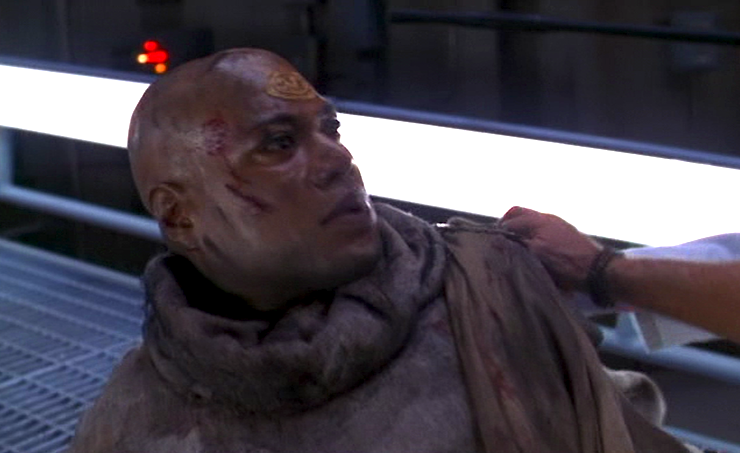
Chevron seven locked. I have an interesting relationship with the sixth season of the show, because it was actually my introduction to SG-1 as a series. I first started watching it on Sci-Fi—in fact, my first episode was “The Other Guys,” which I mostly watched because John Billingsley was in it.
I became hooked at that point. I watched the new episodes on Sci-Fi as well as the reruns the channel was showing (they did a block of four episodes every Monday night for several years).
But because of that, my first impression of the show is this season, which may be why I look on it more fondly than others, many of whom view it as inherently inferior due to the lack of Michael Shanks.
I don’t see the problem, myself. The show works just fine without Jackson because the show has grown to this point where it doesn’t rely on any particular set of characters. And Corin Nemec’s just fine, thanks.
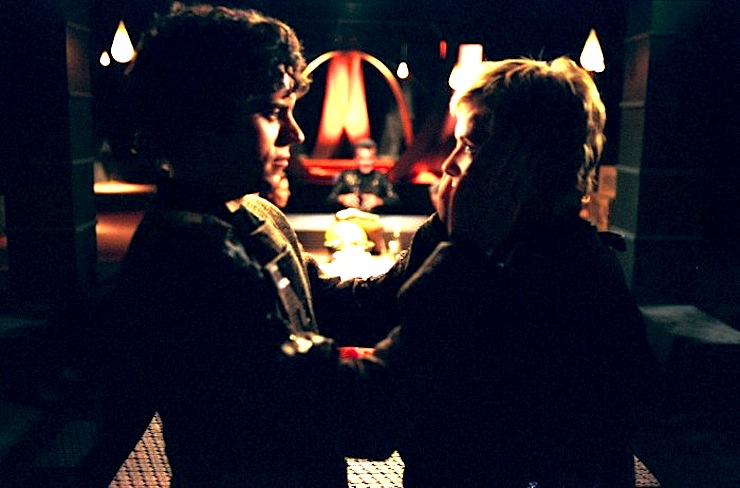
Besides which, so many things that become hugely important to Stargate as a franchise are established here: the Ancients (and the plague that devastated them), the rules of ascension, Earth’s spaceships, Tretonin, the humanform Replicators, Baal. Perhaps representative of its more important place on Sci-Fi than it had on Showtime, in this season Stargate embraces its role as a universe, as a franchise, rather than just an adventure show about four people who go through a gate.
Having said that, the season is a big comedown from the previous year’s heights. Too much time is wasted on what feels like filler—notably silly alien-of-the-week plots like “Sight Unseen,” “Forsaken,” “Memento,” even “Shadow Play,” though that works better because of the direct connection to Quinn—and just in general there are a lot of mediocre episodes here. Plus there’s a lot of retreading. “Descent” feels a little too much like something we’ve seen a thousand times before, “Disclosure” feels way too much like the first season’s “Politics,” “Sight Unseen” is way way way too much like “Bane,” and the “Redemption” two-parter feels like it’s simultaneously retreading “48 Hours” and “Into the Fire.”
The high points, though, are quite high. “Abyss” and “Allegiance” are two of SG-1’s strongest hours. For all that the latter has plot issues, the episode does a superb job of putting Jaffa peanut butter with Tok’ra chocolate and seeing what happens.
Keith R.A. DeCandido’s latest fiction release is “Down to the Waterline,” an urban fantasy set in Key West, Florida involving nixies, ghosts, scuba diving, rock and roll, mysterious murders, and the evils of spam filters. The story is free on the online magazine Buzzy Mag.It’s one of several Key West urban fantasies Keith has written, many of which can be found in the collection Ragnarok and Roll: Tales of Cassie Zukav, Weirdness Magnet.










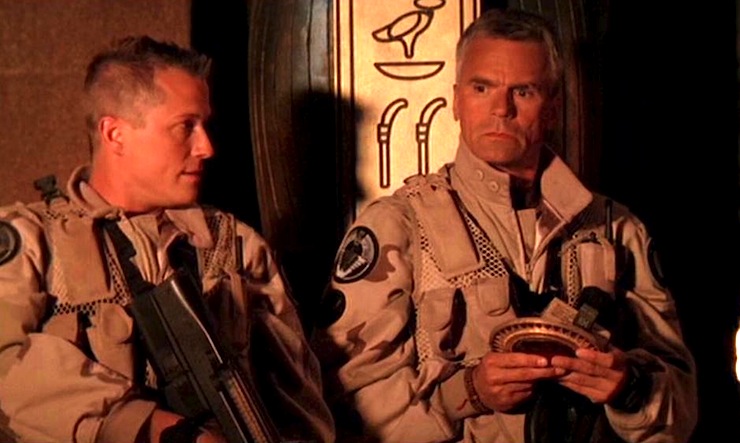
Wasn’t the plague that killed the Ancients already mentioned in Window of Opportunity?
I like Corin Nemic just fine. You started the series with the Other Guys? It’s fun, but I’m glad you came back for more I’m not crazy about comedy episodes and I’m not sure I would have done it. Then again Carter and RDA are awsome. One of the biggest problems I had with this season is that they “killed off” the entire planet of Abydos. I think it’s lazy writting and annoys me a bit less than all of Carter’s love interst dying. I think they were probably going to do the same thing with the Athosians on SGA but that is a discussion for another day.
Yeah, this was my least favorite season until Stargate: Farscape happened. For me at least, Jackson and O’Neill are essential to the show. It didn’t work as well without them together.
The Tok’ra queen’s name is spelled Egeria. She’s presumably named for the minor Roman goddess.
Jonas was okay, but I could take him or leave him. What bugged was that, for a supposed “alien,” he was far too ordinary. He rarely exhibited any signs of having his own distinct culture or beliefs or customs, and only occasionally seemed to struggle with ours. Granted, Teal’c already had those covered, so it might’ve been redundant to ride too heavily on that, but it could’ve worked if they’d made his culture sufficiently distinct from the Jaffa.
For me, the high point for Jonas was “Prophecy,” though not so much because of Jonas himself as because it’s perhaps the best discussion of quantum physics I’ve ever seen on a fictional television series. It’s not as awesome as “Tangent,” but it’s another example of how good their scientific research sometimes was.
On the other hand, you have the whole thing with the Ancients being the first evolution of humanity. I could almost buy the way that was explained in “Frozen,” in which the Ancients evolved on Earth three million years ago and meddled in our evolution to recapitulate their own. That, while a stretch, was at least something I could suspend disbelief about. But it got worse a couple of seasons later when they retconned the Ancients as originating in a whole other galaxy.
We also had the paradox of the Serrakins from “Forsaken,” reptilian humanoids that don’t seem to be descended from the Ancients, yet are somehow capable of interbreeding with humans. That’s a Trekkish cliche that doesn’t really fit the established and implied rules of biology in the SG-verse.
Of course, the really big credibility issue is “Prometheus.” It’s hard to believe they could’ve built a ship this big, in secret, within just five-odd years of starting the Stargate program in earnest. Not to mention that it’s way too cursory a way of ending Col. Simmons’s and Adrian Conrad’s arcs.
Also, I didn’t much care for the human-form Replicators. It seems that every faceless, robotic horde that poses an ongoing threat in an SF universe eventually needs to be given a more human face and voice. The Daleks got Davros, the Borg got the Queen (and Hugh and Seven), and now the Replicators, which I really liked as a change of pace from the usual humanoid villains in SFTV, got their humanized versions as well, and they were just too great a departure from the Replicators. Still, it wasn’t a bad story, though I think O’Neill was a total jerk in the way he dealt with the human Replicators, making things worse in the long run.
Yeah, I always prefered the Ancients as the first evolution of hummanity instead of the Alteran retcon too.
I like Jonas. I wish that they would have kept him, and we would have had a season or two of Carter, T, Jackson, and Quinn making up SG-1.
Teal’c and Carter were the critical characters for me.
I agree with 4/CLB that the show just fails to give aliens any culture at all. Jaffa get an excuse since they are bred to be warriors and priests, but it’s like all these other human societies don’t have art or music or theater or movies. Just give us something along the lines of how every culture has a dish similar to Swedish Meatballs, seriously, I’ll take anything at all.
“The Changeling” is incredible, but I must agree with “Abyss” as the best of the best. Wow, what an episode… for the acting, the plot, and the variable gravity prison.
I do have to disagree with “Paradise Lost” as the worst. Having a few minute cry with your best friend when your other best friend dies and you think it is your fault and you recently lost your other other best friend is a pretty healthy reaction. It’s just a shame that the writers felt it could only be the woman who cried. T couldn’t have mustered a manly single tear? I know it was the 90’s, but come on.
I liked what they did with Carter in Paradise Lost. Yeah it is horrible what happens to her character, but it is very in-character. They’d built up Carter and O’Neill having feelings for each other, and while O’Neill is better at learning to live with loss and not being able to take advantage of opportunities, Carter isn’t. She’s dealt with it by refusing to deal with it, by shoving her feelings away and ignoring them, often by retreating into scientific programs. You can only do that for so long, and Paradise Lost was where she kinda lost it. Made worse because there was a scientific mystery too, which she couldn’t solve and could not get lost in. She lost perspective and it made her start to deal. I thought it was great character stuff.
The Prometheus kinda irked me too. However I contain my earnest expression of disbelief with the knowledge that in wartime (real wartime) engineering moves on really fast, so if they cut all the usual corners which are designed to feed Boeing and Lockheed pork and took on direct control of the project, then they could have maybe managed it. And the Prometheus is pretty much a basket case of a ship. For the first short while it is more a flying collection of malfunctions than anything else.
Human form replicators I liked. What I liked is that it was a very clear message that pragmatism and making the “hard choices” just makes things worse. Instead of a massive galactic war, they could have had a rock solid ally and all that it would have been needed to gain an ally that could have given them and the Asgard everything on the replicator threat was O’Neill not acting paranoid. But he takes the pragmatic and paranoid approach, and everyone gets screwed by that. It is the same message you get from Star Trek, trust and goodwill works, but delivered in a way that it shows you the effects of not trying them. If only the Atlantis expedition could have learned that lesson.
@7/Random22: That “wartime” argument might make sense if you’re talking about inventing a new kind of weapon based on known, existing theory, like the Manhattan Project. But building a functional hyperspace starship involved gaining an understanding of whole new areas of physics that had only been known about for a few years, things there wasn’t even a prior theoretical underpinning for. That’s a much huger hurdle to surmount. Okay, maybe they had help from someone like the Tok’ra or the Tollan in figuring out the underlying theory, but it still feels like too big a jump, too soon.
I wish at least they’d established that the hyperspace engines were salvaged from a crashed Goa’uld mothership or leased from the Tok’ra or something (although I recall the Tok’ra weren’t too happy about Earth’s swift advancement and wouldn’t have been likely to do that).
@8. In fairness, as I said, they don’t really understand it and the Prometheus is not really properly functional as a starship until much later. Plus they’ve been agressively yanking everything they’ve found in hyperspace and other off-world science thingies. It just about works, but only just. Now the rapid advancement from the Prometheus to the next, much more complicated and larger, class. That one I have problems with. I don’t care how much Asgard help they got on that puppy.
One thing I have not touched on in my comments on this rewatch is my least favorite thing about the show: that aliens buried something in Antarctica. No, no, freaking no. If you’re going to couch a lot of your show’s mythology in Egyptian history and legend, I can suspend my disbelief and pretend that aliens built the pyramids. If you put a stargate there, I can handle that, because everything is all wrapped up in Egyptian lore anyway. It’s a connection between the alien worlds of the show and our real world, because, y’know, there really are pyramids, and people really did worship Anubis.
But Antarctica? No. There were no humans on Antarctica until 1821. There is no lore of Antarctica to put into the show. It’s a vast frozen wasteland, and there is no reason for me to feel a connection to it in any way. It feels like a cop-out, honestly. I remember watching the show originally, and every time they’d go to Antarctica, I had this sense of “what are we doing here?” It’s like a writing cheat. Fine, writers use cheats, but I just…ugh. I’m definitely overthinking it, but I just don’t like that aliens buried anything in Antarctica. Sigh.
I’m also not a fan of Quinn “replacing” Jackson, because they’re fairly different people. They needed a fourth person on the team, we needed another character on the show, and I like Quinn a great deal, but – he’s not “replacing” Jackson because he serves a different function to the team.
Apparently this season makes me angsty. Huh!
@10/MeredithP: I don’t understand the problem with bringing in Antarctica. The Ancients aren’t like the Goa’uld. The Goa’uld were parasites who came to Earth and co-opted our existing mythologies as a tool for wielding power over their human slaves. The Ancients lived on Earth millions of years ago, before our species of humanity even evolved, and predated anything specific to our civilization or history.
Indeed, per the timeline established in the spinoff series, the Ancients lived on Earth for tens of millions of years before the plague wiped them out and they abandoned it for the Pegasus Galaxy. So they weren’t aliens, they were Earth natives (from the first generation born here onward, anyway), and inhabited the planet for far longer than we did. So why wouldn’t they have occupied Antarctica? It wouldn’t even have been frozen yet when they first lived on Earth.
@11/CLB – True – but I think it’s the lack of connection to actual history, for me. Like I said, with Egypt, I’m able to make connections between the world of the show and the real world. With Antarctica, it’s wholly crafted, in a story that’s supposed to take place in the real world (of a sort).
You’re quite right, of course, and your point softens my feelings a bit. But I still just don’t like using Antarctica, because I have no peg on which to hang the historical connection. Perhaps if it had been in North America, and a Native American component had been added, or in Australia with an aboriginal component, I might have liked it more. I just wish that a show set (ostensibly) in the real world, with connections (ostensibly) to real world history, had maintained some of that.
You know, I used to really complain about how unrealistic it was that the Prometheus was built after only six or so years of access to alien tech, but that’s way more sane than what we got in the Bill McCay novels. There, Earth built hundreds of satellites with reverse engineered not-Goa’uld energy cannons that could vaporize Ceres, plus a bunch of anti-gravity engines for space shuttles and anti-grav missiles, in less than a year and with an absurdly limited not-Naquadah supply collected from Abydos over the course of months. And for many of those months, the miners were using Bronze Age tools to do their work too, so they had horrible productivity.
Thank god someone decided to Let’s Read those books on a forum I frequent, because I can’t imagine paying actual money for that stuff. They sound like bad fanfics (even though they were at least partially based on notes from Roland Emmerich and Dean Devlin).
I get what you say about Carter’s character, but it never really came off that way to me. I liked the scene with Teal’c because it showed that A) the character’s are actually trying to deal with Daniel’s “death” instead of being like, ok, he’s dead, let’s do the next episode, and B) I feel like it helps to highlight the friendship between Carter and Teal’c. Usually you get the impression that Teal’c is O’Neill’s best buddy, and sometimes you get the scenes where he and Daniel mutually respect each other, but it’s nice to see that these people are all genuinely friends in their downtime. In particular, I don’t feel like Carter and Teal’c get enough interaction.
Jonas is awesome, and I liked him working with Daniel at the beginning of season 7. I wish they had been able to bring him back more than just once after that.
@MeredithP:
First of all, the Ancients didn’t “bury” anything in Antarctica; at the time the Ancients lived here, there was only one continent; Pangea. Antarctica would have simply been a very temperate subcontinent. They die off, leaving behind their tech. Antarctica is the only feasible location for an Ancient city/base/etc to actually EXIST on Earth and not completely destroy all suspension of disbelief.
I hear you when you say that for you, it didn’t tie into history, like the rest of the show, so it bugged you. For me, I had previously been exposed to Antarctica as a potential source of the Atlantis Myth, through the work of Charles Hapgood and his (since debunked) Theory of Crust Displacement (which was endorsed by Albert Einstein), so it was awesome to see the show include some of that in a way that made sense with their own mythology. I loved it.
@15/anthonypero: Sorry, your timing is way off. According to the Stargate Wiki, the Ancients arrived on Earth sometime before 60 million years ago and left maybe 3-5 million years ago. The Pangaea supercontinent began its breakup about 175 million years ago and was already pretty thoroughly broken up by the time the Ancients arrived. When they first got here, Antarctica would have still been joined to Australia and New Zealand, with a spit of land connecting it to South America. But it split from Aus/NZ about 40 million years ago, and from South America about 23 million years ago, at which point the continent began to freeze over in earnest.
@16:
Intersting. Any idea how everything got buried then? Did the show actually say that the Ancients buried it? I was (obviously) under the impression at the time that it just iced over…
Although, based on the timeline you are giving @16, the Ancient outpost in the Antarctic COULD have been iced over rather than buried, if they built it early in their stay.
@17/anthonypero: “Rising” revealed that Atlantis had been in Antarctica for millions of years (ugh, the sloppy Ancient timeline) before they fled to the Pegasus Galaxy, and that Ayiana, whom we met in “Frozen,” had stayed behind in the Ancient outpost. Presumably the Ancients used technology to keep Atlantis free of the ice that covered the rest of Antarctica, and once they left, there was no longer anything to hold the ice back.
So, is it reasonable (or at least possible) to assume that Atlantis was built in more temperate Antartic times?
@19: Well, I have trouble with the idea that a single city could endure for millions of years, I don’t care how advanced it’s supposed to be. As the SG-verse went on, the writers made all sorts of conflicting assumptions about the Ancients’ chronology — sometimes they were tens of thousands of years in the past, sometimes millions of years, and I don’t think the writers really grasped the distinction between those intervals. So the whole thing’s a heck of a mess.
With regards to Prometheous and the short build turn-around, most of the ship shouldn’t be too hard to build in a short-turnaround. Granted, you’re still dealing with gov’t, so the build time should be huge, but if you really do have a crash-program, you are essentially building a retangular Ohio-class submarine (‘m thinking of the launch tubes on the top) and Aircraft Carrier cross with sublight and hyperdrive engines, and a new reactor. And I could swear there was a comment in one of the shows that said they were using an overdriven alkesh hyperdrive, and most of the control crystals were scavanged. So it’s not like the ship was all new-built. Rather like going to a ship scrapyard and cobbling a LHA together out of whatever you could find (Star Junkyard Wars Gate!). The MTBF rate sure seemed to match that idea!
@21/kehcalb: Interesting way of looking at it. That does make a certain amount of sense. (Although I had to look up your acronyms to know what you were talking about.)
@21/@22
The hyperdrive was originally built on Earth, but they replaced it with an Al’kesh hyperdrive in late season 6/early season 7 after the Prometheus’s original naquariah reactor blew up.
Anyway, I do agree that building most of the interior wouldn’t be too hard. A lot of it probably would be the same as a submarine/aircraft carrier, except for the stuff that would probably need trinium/other alien materials (and obviously the outer hull would have a lot of that), just built in a different form factor than normal naval vessels.
I just remember feeling a little confused about the Prometheus in general, feeling as if I had missed something. I think there may have been an earlier episode where someone mentioned something about someone overseeing the 302 and 303 programs, but other than that, Prometheus seemed totally out of the blue. With the F-302, at least we understood that this was the result of trying again after Tangent, but I still struggle to recall earlier mention of working on a large battle cruiser other than the general MO of procuring new technologies.
@24:
Because it was top, top top secret… I’m trying to remember if the whole team even knew about it before the episode in question?
krad, just a minor thing,Gwynyth Walsh plays B’Etor, not Lursa.
Posting late but posting mainly to be supportive of this endevor – my few comments: I likes the actor (although I’m definitely more of a Shanks fan and definite more of a Daniel fan). They did use his character to replace Daniel a bit, it might have made more sense if they had someone like Drs. Lee (or McKay) who both backed up Carter in science bro stuff (as did others) for translations and the stuff Daniel did for the SG team at the home base and on missions.
However, to be fair to the character, he did have some alieness to him – he could absord information and retain it far more quickly than Earth humans – and as far as the series as a whole, they did establish the whole Ra took from Earth and seeded the other Gould system planets so, of course, they were very similar. When they aimed for non-humanoid aliens, they went with pretty cheap-ass effects and still often the aliens were (as with Star Trek) just biped bodies with extra makeup crap. I think it’s only in the last decade where we can expect television shows to have the kinds of effects that are warranted to make this stuff realistic on a day in and day out basis.
Even though it seems to be the most conversation most folks are interested in, I really have nothing to say on the ship (except that at the time and still, I thought it was pretty unattractive, e.g., non-slick, not even as cool looking as say the space shuttle or the Gould gliders [which are from the film], so that probably made me think then it was a typical military deal put together by regular contractors. Additionally, we’ve already establish the NID (and who knows who else) was stealing tech and part of the purpose of the program was to find means to defend the planet; so I’m not really that concerned about it – except for creating even a poor hyper-drive totally on their own.
Totally with most on the Ancient retcons, I’m fine with the Antartic base – and agree it’s part of the issue with the writers that also occurred in the spin-off and later SG-1 eps.
I’m also pretty OK with the selection of what was good and bad this season. Anything that lead to Daniel Jackson coming back to series television stark nekkid can’t be as much of a loss as some folks think herein.
@27/FDS: Yes, of course the Kelownans and other Langarans were Goa’uld-seeded humans, but my point is that their ancestral culture certainly was not 20th-century Americans, and thus it was implausible that Jonas seemed like just a typical American aside from the odd ability like a photographic memory. I’m not talking about humans vs. nonhumanoids, I’m talking about culture, speech patterns, value systems, and the like. There were Russian characters on this show who felt more “foreign” than Jonas, the guy from another planet, did.
I mean, he’s named Jonas Quinn, for Pete’s sake. Quinn is an Anglicized form of an Irish surname, and it probably didn’t exist in that spelling until the Middle Ages. That doesn’t fit the premise that Langara was seeded with humans 3000 years ago.
Okay. So what I gather so far at least, we don’t like Carter experiencing the Statge of Grief she’s found in whilst completing one of the hardest jobs imaginable: SG-1 Member! And Dr. Lee to have the gall to chastise he? Mate, I’ve worked enough Campaigns to know the overtones. It’s a vehicle to show her vulnerable and alone (first General Carter, saved & goes away, Daniel leaves and now her mentor and let’s be honest, her Dude, possibly lost forever? That’s a bit much for anyone, Higher Degrees or Rank Earned) The point ab her melting seems a wee bit too dramatic and the banal women’s vs. men’s roles as applied to anything military and on TV is a bit much.) We get it.
Same as Anartica and Ancients. They didn’t want to directly interfere with human evolution and as their and other races go back many years, Antarctica could’ve offered the safest point of departure for those focused on Ascending and those “observing” . They lived underwater for 100s of years, can’t really blame them for a change of scenery, even freezing arse cold.
Prometheus I agree 100% with crzydroid. Logic is sound and from drawing board to IOC to Time on Target will differ no matter the vehicle system you’re designing and you’ll have to learn to adapt and overcome because the first Block will mess up and you’ll need to use what you have in-Theatre!
Longt8me Gate Fan. I thought the Series was presented in a very cool format and they made use of what they had. As for Jonas, they were nearly as advanced as Earth and Jonas, like T, wasn’t allowed off-base until several weeks afterwards, plus T was checking his Six just in case. As for Additional Cultures, yes, I wished they went further with Greece & King Alexandre III of Macedon. History, Military History is one of my Degrees and it’s what drew me into SG. Like The Genii in SGA, Quinn’s former home and rival powers offered a believable backstory as they embarked on harnessing not only the power of the atom, but of Fission-Fusion Devices sans Teller-Ullam Staged Devices Design Physics and Taylor’s Theories. Placing them on parity with a recent Earth during Cold War I enables them present as modern and adaptable to our culture, besides, most time is spent off-world.
Man. I can’t imagine this Series and Season dropping today. We’d have protests about the damn protests! It’s s brilliant and fun show y’all, smile.